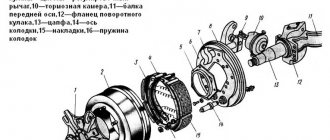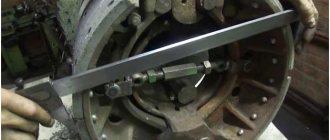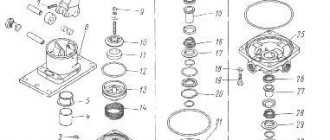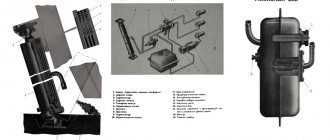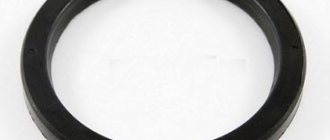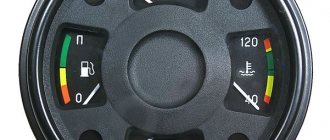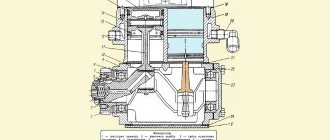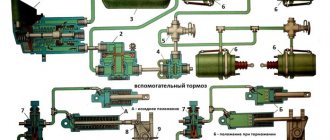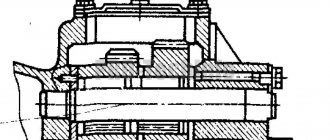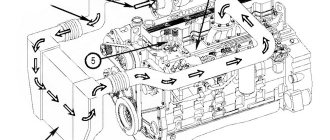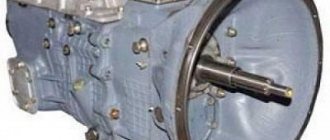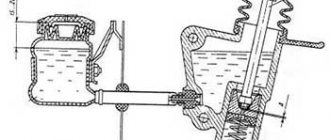Over time, any brake pads wear out, as a result, KAMAZ pads need to be replaced. This process cannot be called complicated, but still replacing KAMAZ Euro pads requires some effort.
Wear of friction materials can be monitored by checking the stroke of the brake chamber rod. When it reaches 4 cm or exceeds this figure, the KAMAZ brake pads are adjusted, but if this is not possible, the KAMAZ brake pads are replaced.
Front brake pads for KAMAZ 6520
The pads of this dump truck differ in their overall dimensions. They must bear a significant load during braking. Parts are classified into several categories. First of all, by its origin. They may be original or made by other brands. In addition, it is possible to purchase an assembly or just the lining itself. The cost varies significantly.
The brake pad assembly is easier to install and does not require riveting. But its cost is much higher.
Simple overlays will cost twice as much. But installing them requires a special tool.
How to move the pads apart and bring them together
Truck braking is ensured by adjusting the brake devices. After replacing the friction material, the car's brakes are completely adjusted. This operation is performed using adjusting eccentrics. Adjustment is necessary in order to bring the pads as close as possible to the brake drum. To check the quality of work performed, use a 0.1 mm thick probe. It should not fit into the gap between the lining and the brake drum.
Partial adjustment is performed in case of reduced braking efficiency or jamming of the pads. As a result of wear of the friction material, the stroke of the brake chamber rod increases.
When the value reaches 35 mm, partial adjustment of the brakes is required.
To spread the pads on a KamAZ, you need to hang the wheel and bring the linings to the drum. Adjustment is carried out only by rotating the axes of the adjusting levers.
The actuator (ratchet) is located under the energy accumulator. To adjust, unscrew the locking bolt 2-3 turns and turn the shaft clockwise with the adjusting screw (worm) until the free rotation of the wheel completely stops. To set the required clearance, you need to turn the worm shaft back 2-3 clicks and tighten the locking bolt. After the adjustment is completed, the effectiveness of the brakes is checked.
If the brake drum heats up while the car is moving, you need to increase the gap between the linings and their contact surface, i.e. bring the pads together. The operation is identical to breeding, only the ratchet shaft is rotated counterclockwise. The quality of the adjustment is checked by the temperature of the brake drum. When the pads are set correctly, it does not heat up.
To ensure uniform braking and prevent the car from skidding, the stroke of the rods of the right and left brake chambers should be approximately the same. When adjusting the brakes, the amount of its movement is set to 20 mm. The permissible difference in indicators is no more than 2-3 mm.
Replacing KamAZ brake pads
Original front brake pads
These parts are distinguished by their quality. As a rule, they last an order of magnitude longer than similar products from other brands. At the same time, such a product will cost 2 times more in the store than its analogue. But if you have enough money, it’s still worth purchasing an assembled, original block. This will allow you to postpone the next replacement for a long time.
| Manufacturer's name | vendor code | Price |
| KAMAZ long lining without asbestos | 6520-3501090 6520-3501090-41 | 3 thousand rubles |
| KAMAZ long lining, cast | 6520-3501090 RT520-3501090-40/41 | 2.5 thousand rubles |
Analogs of front brake pads
The analogs are quite high quality. But the choice will need to be approached as carefully as possible. The replacement process is complicated. It is important to avoid buying counterfeits. They are often manufactured for well-known brands. Counterfeit products can cause accidents and wheel jams.
Poor quality pads can simply turn inside the drum.
The following models have proven themselves well:
| the name of detail | vendor code | Price |
| MASHDETAL | 66520-3501090-51 | 4 thousand rubles |
| AKKOR | 6520-3501090 | 1.5 thousand rubles |
| TRW | 520-3501090-40/41 | 2.5 thousand rubles |
Rear brake pads for KAMAZ 6520
It is important to monitor the rear brake pads on KAMAZ 6520 especially carefully. A dump truck involves a significant load on the axle under the bucket. Therefore, the wheels are subjected to serious testing during braking. Most often, problems with pads jamming in the drum occur on the rear axles. It is possible to purchase original KAMAZ parts and their analogues of varying quality. They also differ in price.
How to move the pads apart and bring them together
Truck braking is ensured by adjusting the brake devices. After replacing the friction material, the car's brakes are completely adjusted. This operation is performed using adjusting eccentrics. Adjustment is necessary in order to bring the pads as close as possible to the brake drum. To check the quality of work performed, use a 0.1 mm thick probe. It should not fit into the gap between the lining and the brake drum.
Partial adjustment is performed in case of reduced braking efficiency or jamming of the pads. As a result of wear of the friction material, the stroke of the brake chamber rod increases.
When the value reaches 35 mm, partial adjustment of the brakes is required.
To spread the pads on a KamAZ, you need to hang the wheel and bring the linings to the drum. Adjustment is carried out only by rotating the axes of the adjusting levers.
The actuator (ratchet) is located under the energy accumulator. To adjust, unscrew the locking bolt 2-3 turns and turn the shaft clockwise with the adjusting screw (worm) until the free rotation of the wheel completely stops. To set the required clearance, you need to turn the worm shaft back 2-3 clicks and tighten the locking bolt. After the adjustment is completed, the effectiveness of the brakes is checked.
If the brake drum heats up while the car is moving, you need to increase the gap between the linings and their contact surface, i.e. bring the pads together. The operation is identical to breeding, only the ratchet shaft is rotated counterclockwise. The quality of the adjustment is checked by the temperature of the brake drum. When the pads are set correctly, it does not heat up.
To ensure uniform braking and prevent the car from skidding, the stroke of the rods of the right and left brake chambers should be approximately the same. When adjusting the brakes, the amount of its movement is set to 20 mm. The permissible difference in indicators is no more than 2-3 mm.
Original pads
Original brake linings will cost relatively inexpensively for original ones - in the range of 2-3 thousand rubles. What is especially important. Since replacement is required relatively often. KAMAZ 6520 dump trucks have certain features. One of these is the rapid wear of the rear pads. The replacement process is not complicated, but it is labor-intensive. Requires an assistant.
| Name of part and manufacturer | vendor code | Price |
| KAMAZ cast lining | 6520-3501090-40 | 2.3 thousand rubles |
Replacing front pads
The procedure is relatively simple. Typically, disc brakes are installed on the front wheels. The principle of their design is similar to those installed on conventional passenger vehicles. But there are also some serious differences. The procedure for removing old pads itself includes the following steps:
- the wheel nuts are unscrewed, the front axle of the KAMAZ is raised on a jack - then the required wheel is simply removed;
- it is necessary to unscrew the cap of the expansion tank - this will avoid difficulties when pressing in the brake cylinder to remove the caliper;
- the caliper guide is unscrewed, the fixing brackets must be removed using a screwdriver (if there is a wear sensor, it is important to turn it off);
- Using a flat screwdriver, you will need to spread the pads, then press the brake piston in and remove the brake pads.
Installing new pads occurs in the reverse order.
Maintenance of the KamAZ brake system. Part 1.
Maintenance of the KamAZ brake system
Part 1
Maintenance of the KamAZ brake system consists of inspecting, cleaning the mechanisms and checking the fasteners, as well as adjusting the gaps between the pads and the drum.
When inspecting the brake mechanisms, you must check the following:
1. Reliability of fastening the calipers to the axle flanges.
2. Tightening the nuts of the pad axles and the nuts of the bolts securing the expansion knuckle brackets.
3. Condition of friction linings. If the distance from the surface of the linings to the heads of the rivets is less than 0.5 mm, then the brake linings need to be replaced. It is necessary to protect the linings from contact with oil, since the frictional properties of oiled linings cannot be completely restored by cleaning and washing. If you need to replace one of the left or right brake linings, you need to change everything on both brake mechanisms (left and right wheels). After installing new friction linings, the block must be bored out. The shoe radius of 200-0.4 mm is given in relation to a new drum. After boring the drum during repair, the radius of the block should be equal to the radius of the bored drum. Drums can be bored to a diameter of no more than 406 mm.
4. Rotation of the expansion fist shaft. The shaft should rotate freely in the bracket, without jamming. Otherwise, you need to clean the supporting surfaces of the shaft and bracket, and then lubricate them with a thin layer of grease.
Adjustment of the KamAZ brake mechanism can be complete or partial. In both cases, it is necessary to check whether the wheel bearings are tightened correctly. The brake drums must be cold. The parking brake should be turned off.
Full adjustment of the KamAZ brake system is carried out only after disassembling and repairing the brakes or in case of misalignment of the working surfaces of the friction linings and the brake drum.
The necessary operations must be performed in this sequence.
1. Loosen the nuts securing the pad axles and bring the eccentrics closer together, turning the axes with the marks facing each other. The marks are placed on the outer ends of the axles, protruding above the nuts. Loosen the expansion knuckle bracket mounting bolts.
2. Supply compressed air to the brake chamber at a pressure of 1-1.5 kgf/cm2 (press the brake pedal if there is air in the system or use compressed air from a garage unit).
If there is no compressed air, remove the brake chamber rod pin and, pressing the adjusting lever towards the stroke of the brake chamber rod when braking, press the shoes against the brake drum.
By turning the eccentrics in one direction or the other, center the pads relative to the drum and achieve a tight fit to the drum. After this, through the windows in the brake shield, located at a distance of 20-30 mm from the outer ends of the linings, direct a 0.1 mm thick feeler gauge under the lining; it should not run along its entire width.
3. Without stopping the supply of compressed air to the brake chamber, and in the absence of compressed air, without releasing the adjustment lever and holding the axles of the pads from turning, securely tighten the axle nuts and the nuts of the bolts securing the expansion knuckle bracket to the brake caliper.
4. Stop the supply of compressed air, and if there is no compressed air, release the adjusting lever and attach the brake chamber rod.
5. Rotate the worm axes of the adjusting lever so that the stroke of the brake chamber rod is within 20-30 mm.
Make sure that when turning the air supply on and off, the brake chamber rods move quickly, without jamming.
6. Check how the drums rotate: they should rotate freely and evenly, without touching the pads.
After the indicated adjustment, there may be the following gaps between the brake drum and the pads: at the expansion knuckle 0.4 mm, at the axles of the pads 0.2 mm.
Partial adjustment of the KamAZ brake system is carried out only to reduce the gap between the pads and the drum, which increases during operation due to wear of the linings. The presence of large gaps, at which partial adjustment is required, is detected by an increase in the stroke of the brake chamber rods (the stroke of the rod should not exceed 40 mm). Partial adjustment is performed only by rotating the axes of the worms of the adjustment levers in the same way as with full adjustment (see paragraphs 5 and 6). In this case, you should not loosen the nuts of the shoe axles and change the installation of the axles, as this may disrupt the normal fit of the shoes to the drum during braking. If the installation of the axles is changed, a full adjustment must be made.
